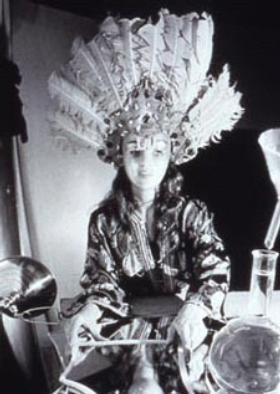Joan Jonas
dal 15/12/2003 al 14/3/2003
Segnalato da
15/12/2003
Joan Jonas
Queens Museum of Art, New York
Five Works. The exhibition includes a selection of the artist's most significant installations, a video room, and a survey of Jonas' drawings, photographs, and sketchbooks. Curated by Valerie Smith, QMA Director of Exhibitions, the show brings together key works from Jonas's career

The Queens Museum of Art presents Joan Jonas: Five Works, the first major exhibition of the American artist Joan Jonas's work in a New York museum. The exhibition includes a selection of the artist's most significant installations, a video room, and a survey of Jonas' drawings, photographs, and sketchbooks. Curated by Valerie Smith, QMA Director of Exhibitions, the show brings together key works from Jonas's career including Organic Honey's Visual Telepathy (1972), The Juniper Tree (1976), Volcano Saga (1985), Revolted by the Thought of Known Places... (1992), and Woman in the Well (1996/2000). This exhibition also includes her portable My New Theater series (1997-1999) and Lines in the Sand (2002), which she will perform at The Kitchen in February.
Joan Jonas (b. 1936) is one of the most important women artists to emerge from the late 1960s and 1970s. Working in New York as a sculptor, by 1968 she moved into what was then considered new territory – mixing performance with props and mediated images, situated outdoors in natural or industrial environments. In her early works, such as Wind (1968), Jonas filmed performers stiffly passing through the field of view against a wind that lent the choreography a psychological mystique. Songdelay (1973), filmed with telephoto and wide-angle lenses, drew on Jonas' recent travel in Japan where she saw groups of Noh performers clapping wood blocks and making angular movements.
Jonas' video performances between 1972 and 1976 pared the cast to one actor, the artist herself performing in her New York loft as Organic Honey, her seminal alter-ego invented as an ''electronic erotic seductress,'' whose doll-like visage seen reflected bits on camera explored the fragmented female image and women's shifting roles. Drawings, costumes, masks, and interactions with the recorded image were effects that optically related to a doubling of perception and meaning. For Jonas, in Organic Honey and earlier performances, the mirror became a symbol of (self-) portraiture, representation, the body, and real vs. imaginary, while also sometimes adding an element of danger and a connection to the audience that was integral to the work.
In 1976 with The Juniper Tree, Jonas arrived at a narrative structure from diverse literary sources, such as fairy tales, mythology, poetry, and folk songs, formalizing a highly complex, nonlinear method of presentation. Using a colorful theatrical set and recorded sound, The Juniper Tree retold a Grimm Brothers tale of an archetypal evil step mother and her family. In the 1990s, Jonas' My New Theater series moved away from a dependence on her physical presence. The three pieces investigate, in sequence: a Cape Breton dancer and his local culture; a dog jumping through a hoop while Jonas draws a landscape; and finally, using stones, costumes, memory-laden objects, and her dog, a video about the act of performing.
In her installation/performance commissioned for Documenta11, Lines in the Sand (2002), Jonas investigates themes of the self and the body in a performance installation based on the writer H.D.'s (Hilda Doolittle) epic poem ''Helen in Egypt'' (1951-55), which reworks the myth of Helen of Troy. Jonas sited many of her early performances at The Kitchen, including Funnel (1972) and the screening of Vertical Roll (1972). Lines in the Sand (2002) will be Jonas's first performance in New York in over ten years. Jonas' works were first performed in the 1960s and 70s for some of the most influential artists of her generation, including Richard Serra, Robert Smithson, Dan Graham and Laurie Anderson. While she is widely known in Europe, her groundbreaking performances are lesser known in the United States, where as critic Douglas Crimp wrote of her work in 1983, ''the rupture that is effected in modernist practices has subsequently been repressed, smoothed over.'' Yet, in restaging early and recent works, Jonas continues to find new layers of meanings in themes and questions of gender and identity that have fueled her art for over thirty years.
The Queens Museum of Art Flushing Meadows Corona Park
Queens, New York City 11368
718 5929700
Hours: Monday - Friday: 7:00am - 5:00pm
Saturday: 10:00am - 4:00pm





